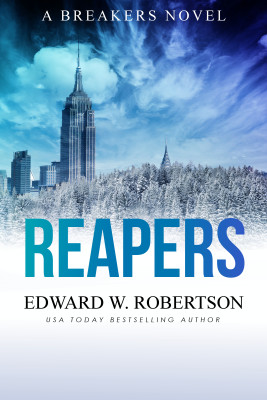Drumroll: The Zombies of Hobbiton: Martian Love Story, an 85-page novella, is now available on Amazon.
At nearly 25,000 words, The Zombies of Hobbiton falls squarely into novella territory. This is another way of saying it’s completely unsalable.
Big book publishers wouldn’t touch a story of that length. Even the shortest genres, category romance and such, is expected to crack 60,000 words or so. A sci-fi or horror novel had better run at least 75K. I suppose it’s possible a traditional publisher would sell a few novellas bundled together, or one inserted among an anthology, but frankly, to sell a story of that length, a story that may well take up 20-25% of the anthology’s total page count, you either have to be extremely good or already well-established.
The same rule of thumb applies over at the genre magazines. Duotrope.com. Duotrope lists 200 paying horror markets and 227 paying sci-fi markets (there is some overlap here). Of these, two pro-paying magazines (that is, markets that pay at least $0.05/word) accept novellas up to 25K words: Fantasy & Science Fiction, at 25K, and Analog, at an impressive 40K. If you place a 25K story at one of these markets, you’ll do pretty well for yourself: F&SF would shell out $1500 for your story (a little more if you’re established), and Analog would pay $1250 ($1500 if you’re a big name). F&SF buys first North American and foreign serial rights with an option on anthology rights. I’m not sure what Analog asks for, but it’s probably similar, meaning you’d still have a bunch of rights left to sell on down the road.
However, F&SF receives somewhere in the ballpark of 2500+ submissions a year while Analog probably sees around 1000+. These are conservative extrapolations; I expect they receive closer to twice that many.
So if you exhaust both those options, you can turn to lower-paying genre markets. Crossed Genres is a pretty nice little zine, and while they hypothetically accept novellas, they’re currently closed to such submissions. Orb Speculative Fiction takes novellas up to 25K words. If you’re a resident of Australia or New Zealand. If accepted, you’ll be paid $50. (Note: I’m very aware of the difficulties in paying authors high rates for their work, and am not criticizing Orb for their pay rates. Just exploring the novella market.) The Red Penny Papers is an interesting-looking zine that wants gothic, pulpy speculative fiction. They’ll serialize works of up to 25K words, paying $0.005/word (i.e. 10K = $50), capping at $100. (Same disclaimer re: rates applies. I like small markets. Simply making a point.) GigaNotoSaurus, a market specifically for longer stories, takes novellas up to 25K and pays $100, and is newish but pretty well-respected.
In total, I see three other SF/F/H magazine markets that will run novellas, paying $25-40 apiece. Anthologies of various pay rates come and go and will sometimes take long stories.
From there, small presses are a fairly viable medium for novellas. A lot of them sell ebooks, but I’m aware of several that will sell actual print novellas. Small press novella markets still aren’t plentiful–I see 10-12 on Duotrope, and strongly suspect there are significantly more out there–but they exist. Most offer a token advance and royalties. Small presses aren’t normally capable of making you rich, but I have met a couple authors who make a living through them.
So maybe my characterization of novellas as a bastard-length medium that’s utterly unsalable is a little hyperbolic. In truth, you’ve got three options:
1) Try to sell them to a magazine. Between all genres, Duotrope shows seven pro-paying markets for works of 25K words or more, with another ~15 paying at lower rates
2) Sell through a small press. This has the usual small press pros and cons: a stamp of legitimacy, formatting and distribution, and possibly a bigger platform than you can provide yourself vs. splitting revenues. (My experience with small presses is limited, but I’ve enjoyed it)
3) Self-publish through Amazon, B&N, etc.
Given that there is no real traditional route available, 2) is the default option if you want a press backing you. Writing this piece has put them on my radar to explore if/when I write my next novella.
When it comes to 1) and 3), they aren’t mutually exclusive, of course. While some magazines may want permanent e-rights that could conflict with your ability to resell your novella through Amazon etc., many don’t, and some of the ones that do are usually willing to take a story offline after 6-12 months. If I thought I had a chance in hell of placing The Zombies of Hobbiton at Analog or F&SF (I think it’s too slapsticky for them, though I could be wrong), I might have tried them first.
But when I look at media to sell novellas through, I see limited options with serious tradeoffs. Some self-publishing advocates would argue this is no more than a microcosm of all current traditional publishing routes–but if nothing else, it’s even worse for novellas, because you simply have almost nothing to lose. From where I sit, the best path is to publish them yourself and see where it leads.
A few weeks back, I contacted the amazing M.S. Corley about putting together a piece of cover art for The Roar of the Spheres. Yesterday, I got the results:
I am in love with this. Being more verbal than visual, I hadn’t really thought much about what The Roar of the Spheres‘ cover should look like until Mr. Corley asked me for a few ideas and descriptions. His finished product? Isn’t particularly like any of the ideas I sent him.
It’s much, much better.
I’ve released a new book on Kindle: The Roar of the Spheres, currently available for $0.99. It’s a sci-fi novel, a backyard space opera heavy with action and humor.
Heh! Pretty crummy cover, right? Did it myself, that’s why. I’ve contacted a pro I know to work me up a better one, but I wanted to get The Roar of the Spheres up now for a couple reasons: first, it’s currently in the second round of the Amazon Breakthrough Novel Award, and if it makes the next round of cuts, I want it out there for anyone who wants to check out. Second, there may be a few brave souls out there ready to overlook the second-rate cover, fork over a buck, and give it a read. Ideally, one or two of them will toss up a review by the time I have my new cover ready to go. Voila–all ready to market.
I don’t know if this is a better or worse strategy than waiting until everything is absolutely perfect to get it out there. The last thing an indie author* needs is to look unprofessional. At the same time, most newcomers take months to build up their presence. The Roar of the Spheres isn’t going to get much attention good or bad today; that cover will be replaced before more than a handful of people have seen it.
But in the meantime, it’s working its way through Amazon’s system. It’s out there if someone wants to read it. I stand by the body of the book itself. Pretty soon, I’ll be able to give it the snappy suit to match.
*For the record, I don’t self-define as a purely indie author–I’m still writing short stories and selling them to magazines, and unless I get Amanda Hockingsishly rich, I will continue to pursue traditional publishers with my next novel. But in the meantime, anyone who declines to self-publish work they believe in just because of the rapidly eroding stigma against self-published books–I think they’re slamming a door on an unknown and sometimes career-launching new world.
Available here.
So The Adjustment Bureau is a Philip K. Dick adaption. A loose Philip K. Dick adaption. It’s so loose, in fact, the only recognizable Dickish element is the basic plot, where protagonist Matt Damon ends up realizing what he thought about the nature of reality is false. Other than that, well, it’s just another generic sci-fi semi-thriller.
Like I say in the review, I don’t mind when adaptations depart from the source material. But if you’re gonna diverge, you have to fill in the gaps with material of your own. With The Adjustment Bureau, in an attempt to capture people with heart, the focus is squarely on the love story. Fine. Awesome. We all love love. But the details of the Bureau and its rules are flat, unimaginative; the reasons Damon and would-be lover Emily Blunt are kept apart come down to fairly trite rules of life. There’s nothing really there. The end result is something far blander than Dick ever wrote.
Available, as usual, here.
Like I say in the review, I should have guessed Hall Pass was a Farrelly Brothers movie: a bit of genuine sentiment buried under loads of prop shit. Also I had the same gut reaction I normally do to their work: “Well, I kinda respect what they’re doing here, but I just can’t get behind the scene were he drinks the bucket of bull semen.”
Hall Pass did inspire me, however, to begin the Full-Frontal Male Nudity Watch. Cocks have popped up in a lot of comedies lately: Walk Hard, The Hangover, now Hall Pass, among others. Hall Pass features three wangs, including two in the same scene. Groundbreaking recent-comedy history made before your very eyes as you frown and chuckle uncomfortably.
I am very much looking forward to all the upcoming alien invasion movies. Just nine days until I get to see my new hometown blown to meaty cinders in Battle: Los Angeles!















